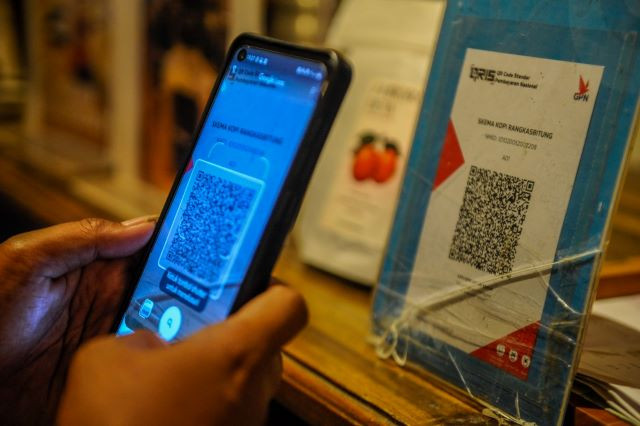Popular Reads
Top Results
Can't find what you're looking for?
View all search resultsPopular Reads
Top Results
Can't find what you're looking for?
View all search resultsBeyond eastern borders: Exploring 2024 Asia Pacific payment trends
With the competition intensifying between merchants competing for a larger slice of cross-border e-commerce pie, 2024 will witness an increasing emphasis on convenience, security, and customer-centric solutions.
Change text size
Gift Premium Articles
to Anyone
 Pay with ease: A buyer scans a Quick Response Code Indonesian Standard (QRIS) to settle a transaction in Rangkasbitung, Banten, on Dec. 9, 2023. Bank Indonesia recorded 1.6 billion transactions using QRIS as of October this year, exceeding its projection of 1 billion. (Antara/Muhammad Bagus Khoirunas)
Pay with ease: A buyer scans a Quick Response Code Indonesian Standard (QRIS) to settle a transaction in Rangkasbitung, Banten, on Dec. 9, 2023. Bank Indonesia recorded 1.6 billion transactions using QRIS as of October this year, exceeding its projection of 1 billion. (Antara/Muhammad Bagus Khoirunas)
T
he year 2023 has gone by in a flash but, as usual in the world of payments, things haven’t stood still - particularly in the fast-paced and fragmented Asia Pacific payments landscape. Statista forecasts that 61.4 percent of global e-commerce revenue will be generated in Asia by 2024.
In a region where one could argue it is the birthplace of QR code-based payments and e-wallets, the further adoption of mobile technology and digital wallets across the region has accelerated demand for cashless payments faster than ever before, and in turn, greatly improved financial inclusion.
According to PwC, e-wallet payments in Southeast Asia are set to exceed US$114 billion in the next two years. Looking more closely at the adoption of digital payments this year in the region, this growth is attributable to many countries - but there are frontrunners.
For example, in India digital payment transaction volumes have already rapidly accelerated post-pandemic, and are expected to grow four times by 2026-2027. This is largely due to government support and adoption strategies and underpinned by India’s instant real-time payment system, Unified Payments Interface (UPI) which, according to PwC, accounts for over 75 percent of digital retail payments in the country.
UPI has set a standard difficult to compete with but many around the region are trying to roll out similar initiatives with Singapore and Malaysia, and even the US publicly commenting on their intentions.
There are also exciting growth opportunities in other key markets such as Indonesia and Malaysia, where consumers' purchasing habits are shifting more rapidly to online - a shift which is catalyzed by the rise of regional super apps like Grab, GoTo (formally known as Gojek) and of course Alipay and WeChat in China.
With so much progression in 2023, what lies ahead in 2024 in the world of Asia Pacific payment trends?
This year we saw further linkages between the real-time national payment networks in Asia. In fact, Asia is leading the charge in the development of these real time payments infrastructure with Singapore’s PayNow, Malaysia’s DuitNow, Indonesia’s BI-Fast, Thailand’s PromptPay, and India’s UPI achieving national break-neck speed adoption with both businesses and consumers, often with direct government sponsorship.
At the national level it has already been shown that these payment networks allow businesses to cut costs and speed up funding timeframes. The focus of the connectivity of these networks across borders up to now has largely been remittance and making payments easier for travelers. 2024 will see a major push of the use of these interconnected national real-time payments platforms into e-commerce applications allowing consumers to use their locally preferred national platform to purchase goods and services from merchants who in turn get cheaper real time settlement.
Blockchain and the use of biometrics in authorizing payments are two of the technological trends that we expect to see grow within the payments ecosystem and will help to redefine the way payments work, making payments faster and greener. These are evolving quite quickly at the moment, and the impact will be seen in the coming years.
Innovation in these two areas are also driving the need to enhance customer privacy and security, particularly as e-commerce scams have continued to metastasize across Southeast Asia, with $700-million being lost to scammers operating mainly from Malaysia, Indonesia, and Vietnam. This issue is expected to remain a major concern as cyber attackers become even more sophisticated in their operations.
Security using biometrics is also creating seamless experiences for consumers – these are being tested by many businesses now and could end up having a huge impact on payments in the next two to three years.
Just last month, at Singapore Fintech Festival, MasterCard showcased new biometric payment technology which is in the early stages of rollout, demonstrating how a simple face scan can be used as payment for coffee. In China, biometric payments have been showcased before but are now gaining traction with the latest adopter being global fast-food chain, McDonald’s using palm scans. For the first time, biometric payments have hit the mainstream, and with further research and innovation, we could expect to see such emerging technology becoming more embedded in our daily lives - who needs their phone in the palm of their hand when you can seamlessly check out with nothing but your palm.
With the competition intensifying between merchants competing for a larger slice of cross-border e-commerce pie, 2024 will witness an increasing emphasis on convenience, security, and customer-centric solutions.
One noteworthy trend will be the continued rise of local payment methods as a major focus of e-commerce merchants. This trend has been fuelled by various factors, which have transitioned millions of users from cash-based transactions to digital payments. This shift away from traditional payment methods is a global phenomenon and is already embedded deeply in how consumers in Asia-Pacific and Southeast Asia like to pay.
It is now more imperative than ever that merchants looking to further capture the opportunity in ASEAN cater toward local payment preferences.
Buy-now-pay-later (BNPL), or cashback schemes will continue to be important. Cash-strapped consumers impacted by the rising costs of living are opting for simplified and innovative ways to pay that also maximize their tight budgets, while being rewarded for their loyalty. This has become increasingly difficult to support given the increased cost of capital and an investor focus on profitability, however, where there is demand there is supply and merchants should ride this wave.
Digital currencies will also evolve in 2024. The central bank in Singapore has announced plans to pilot the live issuance and use of wholesale central bank digital currencies (CBDCs) next year to facilitate real-time cross-border payments and settlements. Whilst this is unlike retail CBDCs which cater to everyday transactions, it signifies a step forward for the future of payments and it will only be a matter of time before consumer e-commerce applications become available.
As always, next year in 2024 will bring new innovation and fresh and exciting applications of existing infrastructure that businesses, merchants and payment professionals will need to keep abreast of. The payments landscape in Asia continues to tell an evolving and compelling story with unrivaled opportunities in the region’s multi-trillion dollar e-commerce industry.
But with advancement comes complexity. To truly make the most out of this scenario, businesses and merchants need to understand the importance of tracking local payment preferences to improve their checkout processes across borders and achieve long-term success in the region.
***
The writer is vice president of Asia-Pacific at PPRO.










